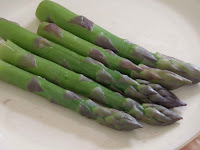 N
Nothing quite says spring like the first asparagus - sweet, tangy and bright in flavor as new grass is to the eye. One of the first crops ready for harvest in spring, asparagus has been enjoyed as a delicacy since the time of the ancient Romans. Today these tender green shoots are coveted around the world for their unique flavor which is at its peak early in the season. After watching pale purple tufts slowly emerge and lengthen for the last week I harvested my first handful from the asparagus bed yesterday. Today another dozen were ready to be cut with more to follow tomorrow and through the rest of the week.
Labor and time are the two things that make asparagus an expensive delicacy. Because the spears emerge in waves over several weeks, they don't "ripen" all at once for easy harvesting and must be hand-picked as individual spears reach the right size. Even more labor goes into white asparagus, which is any regular variety only "blanched" or shaded from light. By gradually

mounding earth around the extending tips as they grow their asparagus are not exposed to the sun and do not develop the usual green color but become a ghostly shade of cream, highly prized for a sublimely subtle flavor. I keep meaning to try this one year but the shoots grow too tall before I get organized.
Establishing an asparagus bed also takes time, several years before you really get the pay-off. After planting roots, spears from the 1st year must not be picked but allowed to grow out into towering fern-like masses. In the 2nd year, harvesting must be kept to only a couple of weeks and only finger thick spears should be taken. It is not until the 3rd spring that the asparagus dream comes true and you are able to harvest continually for a month or more. My asparagus is now 4 years old and sprouting like mad! It will get to a point where I can't keep up with them and will just let them leaf out after about a month, cutting some side shoots here and there for dinner.
 T
The 2 most important things I've learned about cooking asparagus are: 1)snap off (don't cut) the fibrous end and 2)never cook them too long. If you hold a spear in 2 hands, one on each end, and bend the stalk will naturally snap at the point where tender meets woody. Asparagus should always be bright green and have some crispness to it, never be olive drab, soggy or stringy. This 1st bunch I steamed for just under 5 minutes and ate with my hands as soon as they were cool enough to touch. Although these spears were thicker than my thumb they were so tender, succulent and sweet - oh, a divine rite of spring!





